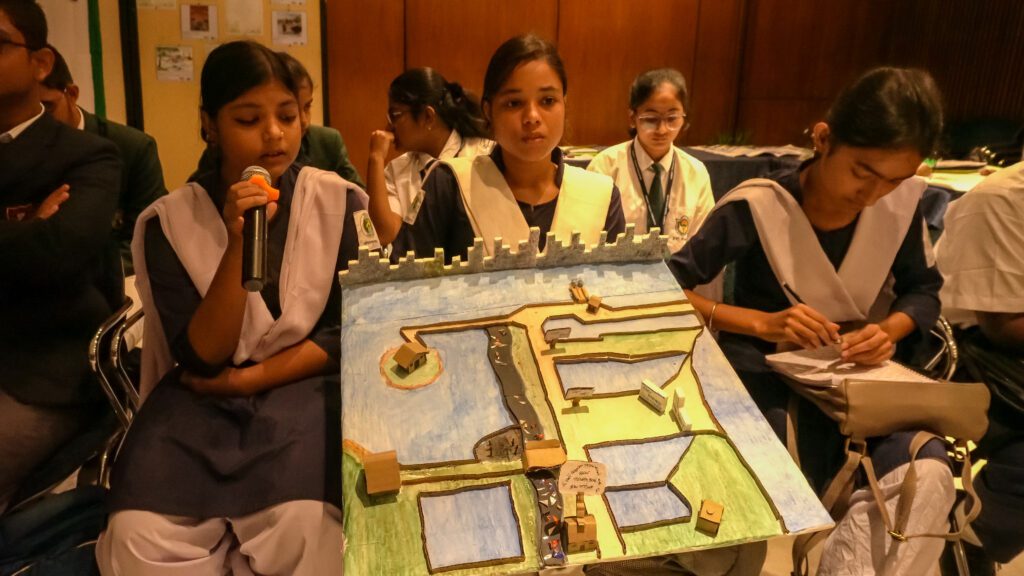The PEIP team on the East Kolkata Wetlands, comprising of (wetland) school students of Bamanghata and Kheadaha, IIT Kharagpur and the Creative Collective Disappearing Dialogues were invited to participate in the “Youth for Climate” programme, organized at the American Center, Kolkata on June 26, 2023 by Living Waters Museum, as part of their Climate Wall Project. The programme focused on discussions centered around the role of protecting and preserving ecosystems and ecological heritage in the Lower Ganga Basin (Kolkata and the Sundarbans delta), through action research such as mangrove plantations, exposure visits, etc.
In the round table discussions attended by students from selected schools in Kolkata and Sundarbans, the wetlands students involved in PEIP shared their critical understandings on the ontologies of ‘urban’, ‘ecology’ and their interconnections. The critical reflections were outcomes of in-depth reflections of their very own everyday lived spatialities, captured through the application of the SMUS toolkit (of ‘ethno-graphy’) via co-learning sessions organized during the first two phases of PEIP execution– Stage 1: Data Collection and Stage 2: Analysis.
The students discussed their experience of involvement and engagements across these two stages using personal narratives from the field, such as their observations from transects walks in the wetland space, understanding the role of city sewage in the ecosystem through ethnography-based conversations with local inhabitants and state officials, etc. They talked about the multiplicities of the wetland ecosystem to their peers from other schools of Kolkata and the Sundarbans – many of whom were unaware of the ecosystem or had minimal information about it. Contrary to the panel deliberations on the antithetical relationship between the ‘urban’ and the ‘environment’ by some students from other schools involved in Climate Wall, where urbanization was castigated as entirely negative/catastrophic, causing pollution, waste management challenges, etc., the PEIP students brought to the fore ‘sustainable flows’ between Kolkata and her wastewater wetlands – the survival and sustenance of both interdependent on each other.
“Kolkata is not our enemy. Without her, the bheris (waste-fed fish ponds) wouldn’t exist…Kolkata and EKW are just like cousins!”
It wasn’t only the city-nature relationship that was reexamined, but even the previously ignored miniscule components of everyday wetland surroundings that played a major role in the wetland’s functioning, was brought forth by the students. The question of preserving the biodiversity of the space, was critically introspected by these young wetland inhabitants, who reflected upon the cyclical nature of multispecies interactions in keeping an ecosystem stable.
“You see sewage as filthy, smelly and disgusting, but for us…and the wetlands, it is life! The bacteria in sewage are the reason our fish thrives, the ponds and greens exist, animals and birds have a home and we all, including the city people can have food on our plates.”
The audience highly appreciated the efforts and cognitive engagements of students to capture complexities and robustness that shape Kolkata’s wastewaterscape. When an invited delegate asked about the source of their awareness and sensitivity in understanding the ecological tapestry encircling the city, one of the PEIP students responded, “We knew all of it, we were encountering them every day. Yet, we were not so thoughtful and keen to probe into this. The last five months have been eye opening for us where we have delved into every detail that we have come across, and beyond.” They also briefly reflected on the several methods that they had used from photography to the art of taking interviews, video documentation, participatory mapping, etc., and shared their perspectives about how they think that these outreach activities could be part of school curricula for spreading ecological awareness among the youth. They also showcased some of the outputs, which included sketches and photographs, a chart paper illustration on the sustainable flows between the city and the wetlands, and a 3D depiction of one of the bheris as part of their PEIP activities and assignments.







